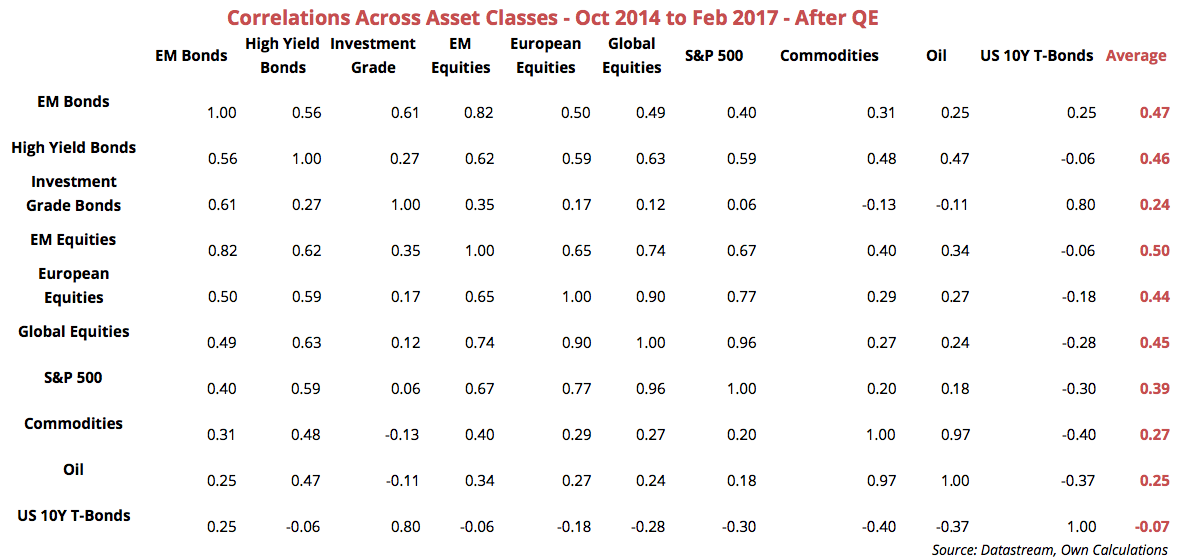What does the decline in correlations among asset classes mean?

One of the worst enemies of a serious long-term investor is a high level of correlation. The main reason for this is that high correlations make all of us the same: you are equal to me and I am equal to Benjamin Graham. We all look fantastically clever or terribly stupid at the same time, no matter the differences in expertise.
When correlations are high, all asset classes look the same, and instead of allocating funds between EM equities, U.S. equities, sovereign bonds, junk bonds and commodities, it’s better to pick just a single asset class, pour everything into it, and spend valuable time elsewhere. In the end, each asset class will move in the same direction as all the others and with pretty much the same strength.
When asset class correlations are high, the extremes converge towards the average. Hedge funds and other actively managed funds fail to convince, in particular because the high fees they charge can’t be justified by the average returns they achieve. Investors prefer to invest in the much cheaper passively managed index funds or even hand pick stocks by themselves.
When that happens, the betas for individual stocks converge to the market beta (which is 1 by the way!), as investors ignore the specific risks of each security. The problem is that when something goes wrong, as it will, everyone will be a seller and the market will crash.
Periods when correlations between asset classes are high are usually periods of irrationality, when the mood is too optimistic or pessimistic and herd behaviour is commonplace. The price of a security loses its basis in fundamentals and bubbles may form (or deflate).
Standard deviation is now double what it was during the period of central bank hegemony.
Last year the IMF reported that correlations had risen significantly since 2010 and warned that “the substantial rise in correlations between asset markets in advanced and emerging market economies points to an increased possibility of contagion or spillovers in periods of stress”.
While the financial crisis of 2008-2009 helped “clean” the mess of the past and contributed to a new decline in correlations, the massive intervention of central banks around the world – in the form of near-zero interest rates and large-scale asset purchases – ensured correlations would remain high. The rise in correlations reported by the IMF is, in fact, a consequence of central bank intervention. The irony of it is that, to save the market, central banks plant the seeds for financial crashes.
But a few days ago, Morgan Stanley published a study of asset class correlations that shows correlations among equities, bonds, currencies and commodities are declining again, in particular since mid-2016. According to the investment bank, these correlations are not only declining but they are at their lowest level since 2006. This means that we finally have a rational market; one in which investors’ opinions diverge; one in which handpicking equities and asset classes may make a difference; and one that is less prone to sudden crashes.
Since mid-year, expectations for further central bank intervention have been pared back as growth has picked up and inflation has begun to rise. Bonds and equities, both of which have benefited from stimulus packages, have finally begun to diverge; money has started flowing away from some emerging economies; debt yields have start gaining traction and spreads are widening across a range of values, instead of clustering around zero; and each asset class has started showing more volatility due to a wider distribution of returns.
Brexit and Trump each played a part in driving markets towards rationality, because both events (good or bad) helped to expand the range of potential scenarios and outcomes, replacing the gravitation around central banks with something healthier.
I made some simple calculations taking into consideration the correlations between the monthly returns of a few different asset classes for the periods between November 2008 to October 2014 and October 2014 to February 2017. The first of these is a period when quantitative easing was in the ascendant, the second is a period of declining intervention. In the first period, the average correlation of global equities with other asset classes was 0.54. The same for the S&P 500 was 0.47. In the latter period, correlation declined to 0.45 and 0.39 respectively.
In terms of average monthly returns and standard deviation, returns for equities declined significantly between the two periods, and the spread of returns for the full group is now wider. Standard deviation is now double what it was during the period of central bank hegemony.
With downside risks no longer being managed by central banks, investors will need to fine tune their portfolios because it is to be expected that different asset classes will perform very differently. Passive investment strategies that for so long outperformed active investment strategies will lose traction, thus prompting investors to carefully seek out value again.
Because not all of us have the tools and expertise to hand-pick securities, pouring money into hedge funds and other vehicles may be an option. But for others willing to manage their own funds, there are a few good ways that may help investors select the right securities and which aren’t too hard to implement. (For more on this, look for the column “How to Invest Like…” in the next Master Investor Magazine issue.)
In terms of risk management, the decline in correlations is very good news because portfolio diversification now makes sense and can be achieved more easily. Diversification across asset classes will now contribute to a reduction in portfolio risk because emerging and developed markets are not moving in tandem, bonds are moving in the opposite direction to equities, and gold is in fact providing protection for those days when equities fall.



Comments (0)